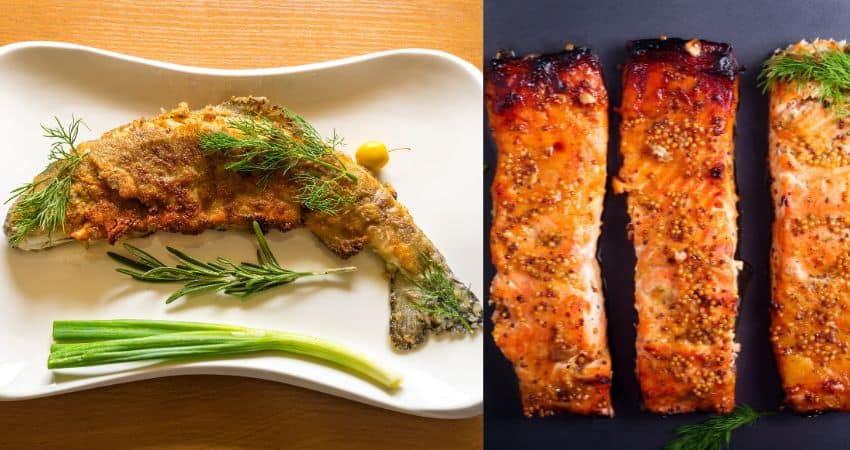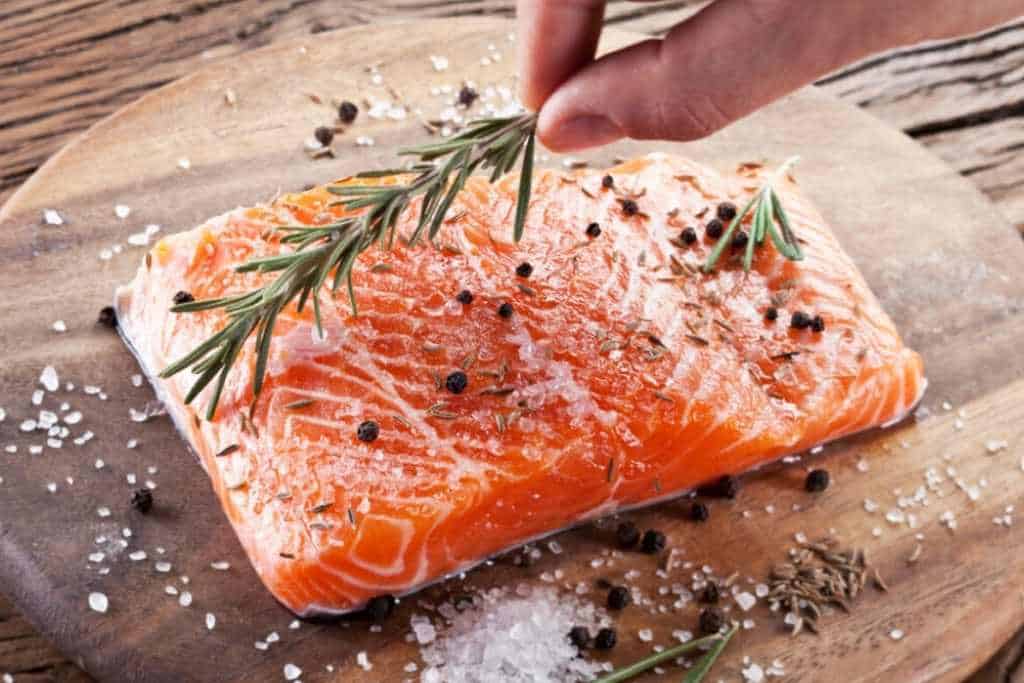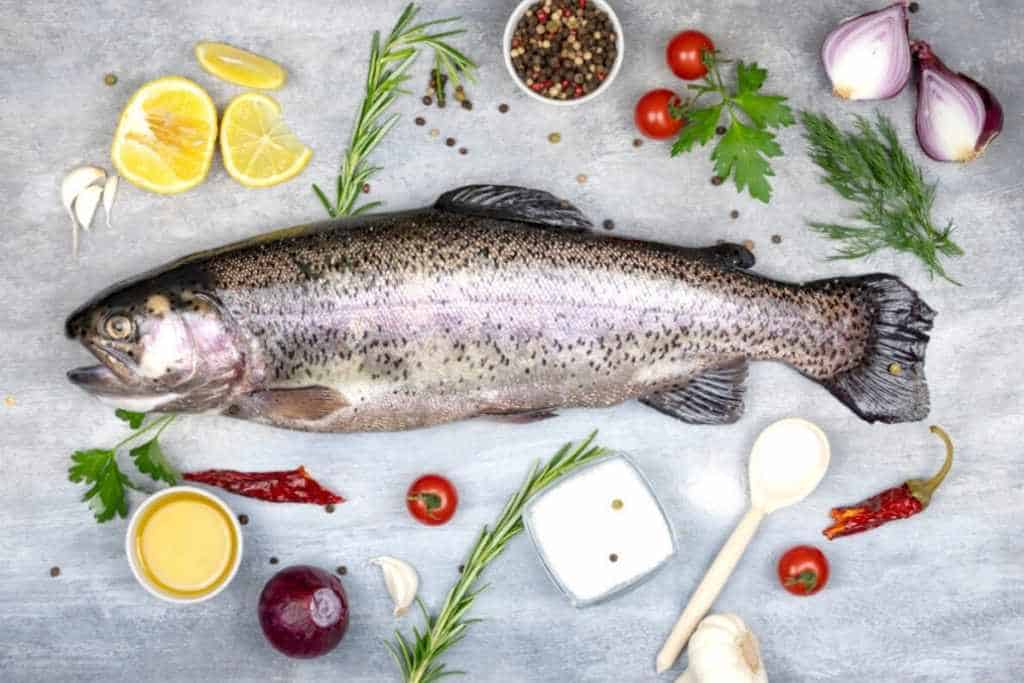Rainbow Trout vs Salmon: Is One Better?
Most people have heard of rainbow trout and salmon because they’re both popular and known to be healthy. This makes some people wonder if one better.
Salmon is better than rainbow trout due to its higher number of omega-3 fatty acids and B vitamins. Salmon provides a greater percentage of B6, thiamin, riboflavin, B5, niacin, folate, iron, potassium and selenium. Salmon’s taste is more rich and buttery than rainbow trouts more milder flavor.
This article will compare both fish nutrients side-by-side. I’ll examine their tastes, textures, mercury levels, costs and cooking methods. In addition, whether one fish can substitute for the other.
Rainbow Trout vs Salmon: Nutrient Comparison

As a Certified Health Coach many clients ask me about food comparisons including trout and salmon. I purchase and consume salmon every week and trout occasionally. Therefore, I have researched this topic in the past and present. Let’s examine them closely.
The table below compares the nutrients of rainbow trout and salmon.
| Nutrient | Rainbow Trout, raw
Wild (4 Ounces) |
Salmon, raw
Wild (4 Ounces) |
| Calories | 135 | 161 |
| Fat | 3.9 g | 7.2 g |
| Saturated Fat | 0.8 g | 1.1 g |
| Cholesterol | 67 mg | 62 mg |
| Protein | 23 g | 23 g |
| Sodium | 35 mg | 50 mg |
| Omega-3 | 0.79 g | 1.95 g |
| B-6 | 0.4 mg | 0.9 mg |
| B-12 | 5.0 mcg | 3.6 mcg |
| Thiamin | 0.13 mg | 0.20 mg |
| Riboflavin | 0.11 mg | 0.40 mg |
| B5 | 1.0 mg | 1.8 mg |
| Iron | 0.7 mg | 0.9 mg |
| Niacin | 6.1 mg | 8.9 mg |
| Folate | 13.6 mcg | 28.3 mcg |
| Potassium | 545 mg | 555 mg |
| Magnesium | 35 mg | 32 mg |
| Phosphorus | 307 mg | 226 mg |
| Calcium | 75.9 mg | 13.6 mg |
| Zinc | 1.2 mg | 0.7 mg |
| Selenium | 14.3 mcg | 41.4 mcg |
Nutrition Sources1 ((Nutrition Value: Fish, raw, wild, Atlantic, salmon))
Examining the nutrients above, both fish contain a high number and wide variety of vitamins and minerals.
Salmon is healthier than rainbow trout due to its greater number of omega-3 fatty acids. Salmon contains 147% more omega-3s which are beneficial for the heart, blood vessels, inflammation and blood pressure. Salmon provides more B vitamins and contains less cholesterol than rainbow trout.
Some people may argue for rainbow trout, but the tie breaker is the omega-3 fatty acids. Salmon contains 1.95 grams per four ounces compared to rainbow trouts 0.79 grams.
Salmon Health Benefits
Salmon provides 23 grams of protein as well. If you’re looking for a fish high in protein, both types are a good option. If healthy fats are what you’re looking for, salmon is definitely the best choice.
Like many fish, salmon protects against cardiovascular disease thanks to the omega-3 fatty acids. The omega-3s have been shown in studies to reduce the risk of heart attack, stroke, cognitive issues and disease like prostate cancer ((National Center for Biotechnology Information: Benefits of salmon eating on traditional and novel vascular risk factors in young, non-obese healthy subjects)).
Omega-3 fatty acids maintains the health of blood vessels and lower bad cholesterol ((National Center for Biotechnology: Marine Omega-3 Supplementation and Cardiovascular Disease)).
Salmon also supports muscular strength, which can take some stress off your bones. Because of the amino acids found in salmon, it has been known to boost mood.
Salmon is also safe and recommended to eat in moderation during pregnancy because of its low mercury levels. Check the mercury section below which provides more details about mercury for both salmon and rainbow trout.
Salmon, like many other fish, is rich in vitamins, Vitamin B in particular. These vitamins are incredibly important to keeping your heart and blood healthy. Salmon also contains a mineral called selenium, which is what keeps your hair and nails healthy.
I wrote another article comparing two salmon powerhouses, Keta and Sockeye. How does sockeye compare in this battle? Check it out here, Keta vs Sockeye Salmon: What’s The Difference?

Rainbow Trout Health Benefits
Rainbow trout contains less calories and total fat than salmon. Vitamins and minerals rainbow trout contains more of compared to salmon are the following:
- B12
- Magnesium
- Phosphorus
- Calcium
- Zinc
Rainbow trout also contains a good amount of potassium beneficial for combating high sodium. This is because it helps the kidneys rid excess sodium and fluids from the body2.
In addition, potassium helps the blood vessel walls to relax. This is important because a stiffer blood vessel makes the heart pump harder and increases blood pressure.
A large number of scientific studies have shown an association between low potassium levels and higher blood pressure ((Harvard Health: Potassium lowers blood pressure)).
Rainbow trout contains a little more magnesium than salmon. Magnesium is beneficial for the heart and improves blood pressure. It achieves this by helping the blood vessels to relax.
In addition, magnesium helps controls other nutrients like calcium and potassium which both benefit high blood pressure and the heart3.
Rainbow Trout vs Salmon: Taste and Texture
Rainbow trout and salmon each have a unique taste. Many people wonder how their tastes compare.
Rainbow trout tends to have a very mild and nutty taste. Salmon has a very strong and rich, oily taste. Salmon and rainbow trout have a tender texture, but salmon tends to be more buttery and rich.
Rainbow Trout Taste and Texture
Rainbow trout is possibly one of the most commonly eaten varieties of trout. This might be because it has a mild flavor. In addition, the fishy aroma that sometimes turns people away from eating fish is minimal.
While some trout varieties need to be caught yourself, you have a good chance of finding rainbow trout at a store or market near you.
As stated above, some people consider trout to have a nutty flavor. Others say it has a flavor that resembles the taste of mild salmon. The strength of the flavor tends to have something to do with where the fish was raised4.
Farm-raised fish in general usually have a more mild flavor than wild-caught fish. This can either be a good thing or a bad thing. If you like fish, you’ll probably prefer freshly caught rainbow trout.
Although if you’re just taking little steps toward becoming a true fish-eater, farm-raised rainbow trout is probably a better taste for you.
Wild caught fish are healthier for you. I wrote a whole article about the differences which you can check out here, Farm Raised Salmon Compared To Wild Caught Salmon.
The texture of rainbow trout fillets can be misleading. They should be firm and fresh but when you cook them, they soften up nicely to give the fish a tender, flaky texture.
If you’re looking for a delicate fish that doesn’t carry much of that potent and characteristic fishy flavor, then rainbow trout is the fish for you.
Salmon Taste and Texture
Salmon tends to have a stronger flavor although it doesn’t necessarily have to be overwhelming. There are many types of salmon and different ways to cook it, both of which have an impact on how intensely the oily fish flavor comes through.
As a general rule, salmon are more flavorful if the uncooked meat is dark red. The lighter, or whiter the meat, the milder the taste will be. For salmon, its flavor has a lot to do with where and how it is raised.
The habitat it lives in will affect how much fat it builds over the course of its life. The more fat there is, the more powerful the flavor will be.
If a particular salmon is raised in colder water, it will produce more fat to keep itself warm. Also, if it’s raised on a farm it will have more fat because it doesn’t have to work as hard to survive.
Like the rainbow trout, salmon has a tender texture but tends to be more buttery and rich. If you would like a stronger flavor with a rich, buttery texture, salmon is the fish for you.

Ways to Cook Rainbow Trout and Salmon
Rainbow trout can be cooked in a variety of ways. Any way that you could cook chicken will probably work on trout too. To be safe to eat, fish needs to be heated to at least 145 degrees, so keep that in mind when choosing cooking times and temperatures.
Flavor Pairing
Cooking up your rainbow trout without any seasonings will result in a rather bland-tasting meal. You’ll want to marinate or cook your trout in some tasty oils, seasonings, and sauces to get the best flavor out of this popular fish.
Each type of fish has a slightly different flavor and therefore tastes best when paired with certain spices. Some common good seasonings to add to your trout are:
- Lemon
- Dill
- Garlic
- Butter
- Scallions
- Rosemary
Because of its mild flavor, using strong or citrus flavors when cooking rainbow trout is a good idea. The intense flavors of your seasonings complement them and add to the taste of the trout.
Ways to Cook Salmon
Just as with the rainbow trout, there are very few wrong ways to cook salmon. It can be baked, broiled, fried or grilled.
One of the best methods is to wrap the salmon and seasonings in individual tinfoil parcels and bake them. The oils from the salmon mix and seasonings soak into the fish, giving it a delightful flavor.
Salmon, with its stronger flavor, doesn’t necessarily go with everything. You’ll want to pair it with seasonings and sauces that compliment it. Some great seasonings to use are:
- Dill
- Fennel
- Tarragon
- Parsley
- Sage
- Basil
- Bay leaves
- Thyme
- Rosemary
- Ground coriander
If you’re the sort of person who likes their fish with sauces, here are some ideas:
- Teriyaki
- Ranch
- Mustard
- Garlic butter and herb
- Soy sauce
- Seasoned cream cheese
There are plenty of delicious ideas out there! Salmon’s rich flavor and buttery texture make it perfect for pairing with all sorts of dressings.
Rainbow Trout and Salmon: Mercury
Mercury levels are a concern, especially for infants and young developing children. Mercury can have a negative affect on physical and mental development. Pregnant women or those breast feeding should monitor their consumption of fish.
The FDA and EPA have issued warnings regarding mercury levels. They also provide recommendations about how often people should consume them5.
The FDA established a list of best choices, good choices and ones to avoid.
Rainbow trout and salmon have similar levels of mercury. They are both listed on the FDA’s best choices of fish to consume regarding their mercury levels. The recommendation is consuming them no more than two to three servings a week.
It’s important to note, other trout, like sea trout or steelhead are listed in the good choices and only once per week category.
Always check with a physician prior to eating new foods or changing your dietary habits.
If you’re interested in finding out how the coho salmon compared to king salmon, check out my article here, Coho Salmon vs King: What’s The Difference?
Rainbow Trout and Salmon: Prices
Prices can vary from season to season, as well as from store to store. Whether the fish is farm raised or wild caught will affect the price and the area where you live.
Buying fish from a local supermarket will typically be more affordable than a fish market. The fish won’t be as fresh, but they’ll be much cheaper.
Rainbow trout and Atlantic salmon costs the same. The average cost for fresh farm raised Atlantic salmon fillets is $9.99 per pound and the average cost for fresh rainbow trout fillets is $9.99 per pound.
I visited and checked my local Shoprite supermarket for the current prices of each.
- Fresh, farm raised Atlantic salmon
- $9.99 per pound
- Fresh, rainbow trout fillet
- $9.99 per pound
- Fresh Atlantic salmon steak
- $9.99 per pound.
It is definitely more cost-effective to buy your fish from the local store than a fresh fish vendor. Because store-bought fish is usually packaged, frozen, transported, then thawed, the taste and texture might be compromised.
If you’re really trying to get an authentic fish experience, get some freshly caught. They may be more expensive, but the flavor is stronger and more real.
If you have any questions to ask me about this article don’t hesitate to comment below or email us. You can find an email on our contact page.
Read Next – More Salmon vs Fish Articles!
Trout vs Salmon: Is One More Healthier Than The Other?
Steelhead vs Salmon: Which Is Better?
Halibut vs Salmon: Which Is Better?
Char vs Salmon – A Complete Comparison
- Nutrition Value: Fish, raw, wild, rainbow, trout [↩]
- American Heart Association: How Potassium Can Help Control High Blood Pressure [↩]
- National Institutes of Health: Magnesium [↩]
- Wikipedia: Rainbow trout [↩]
- FDA: Advice about Eating Fish [↩]
